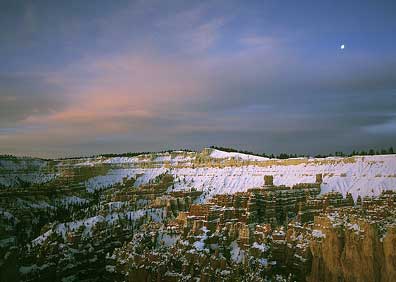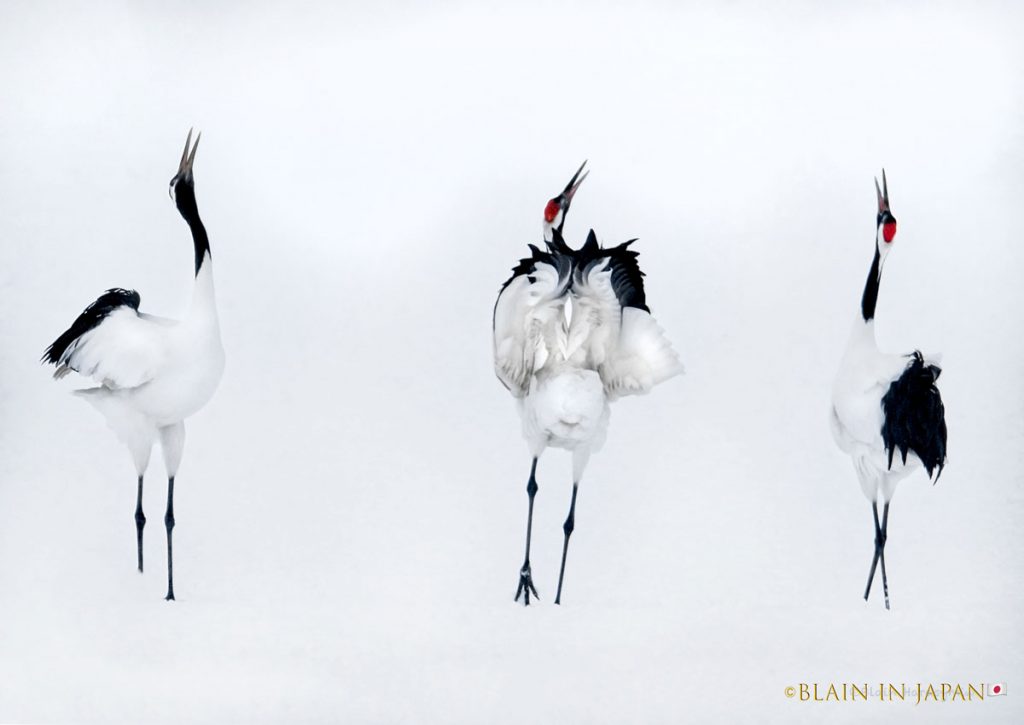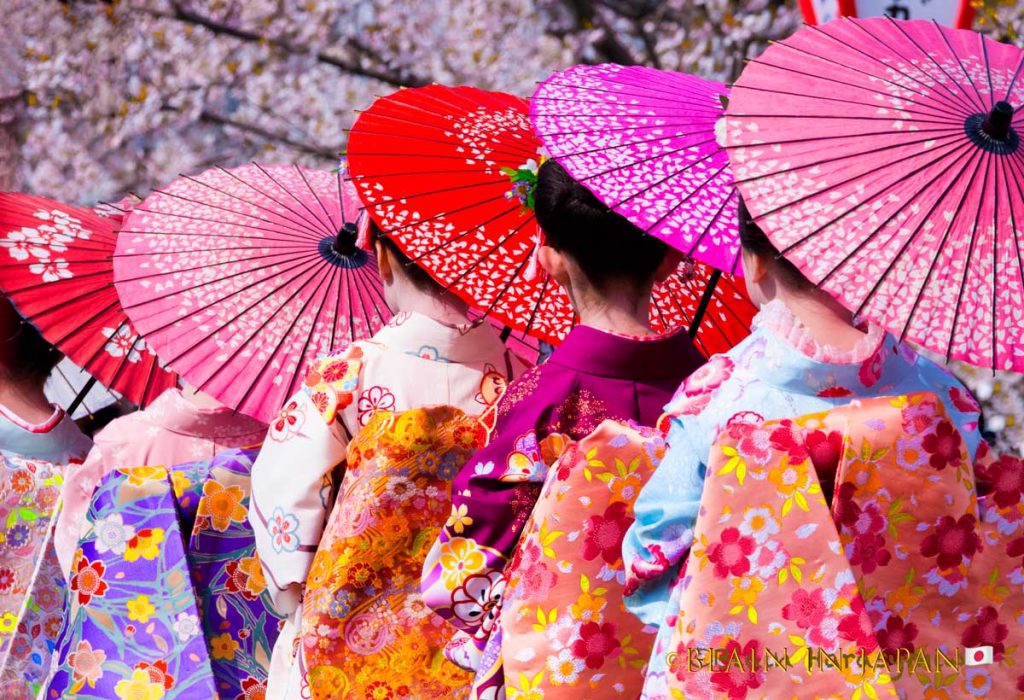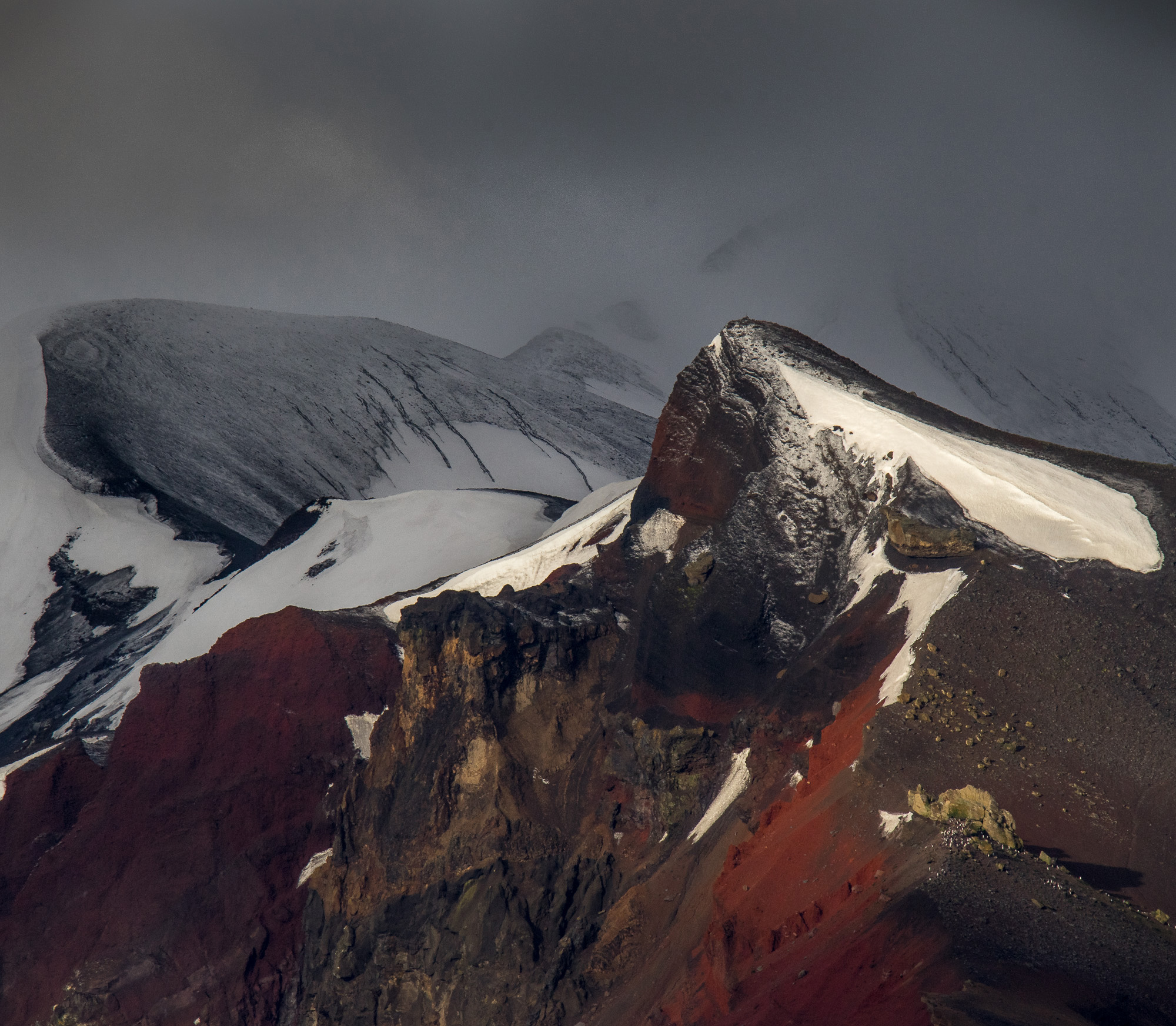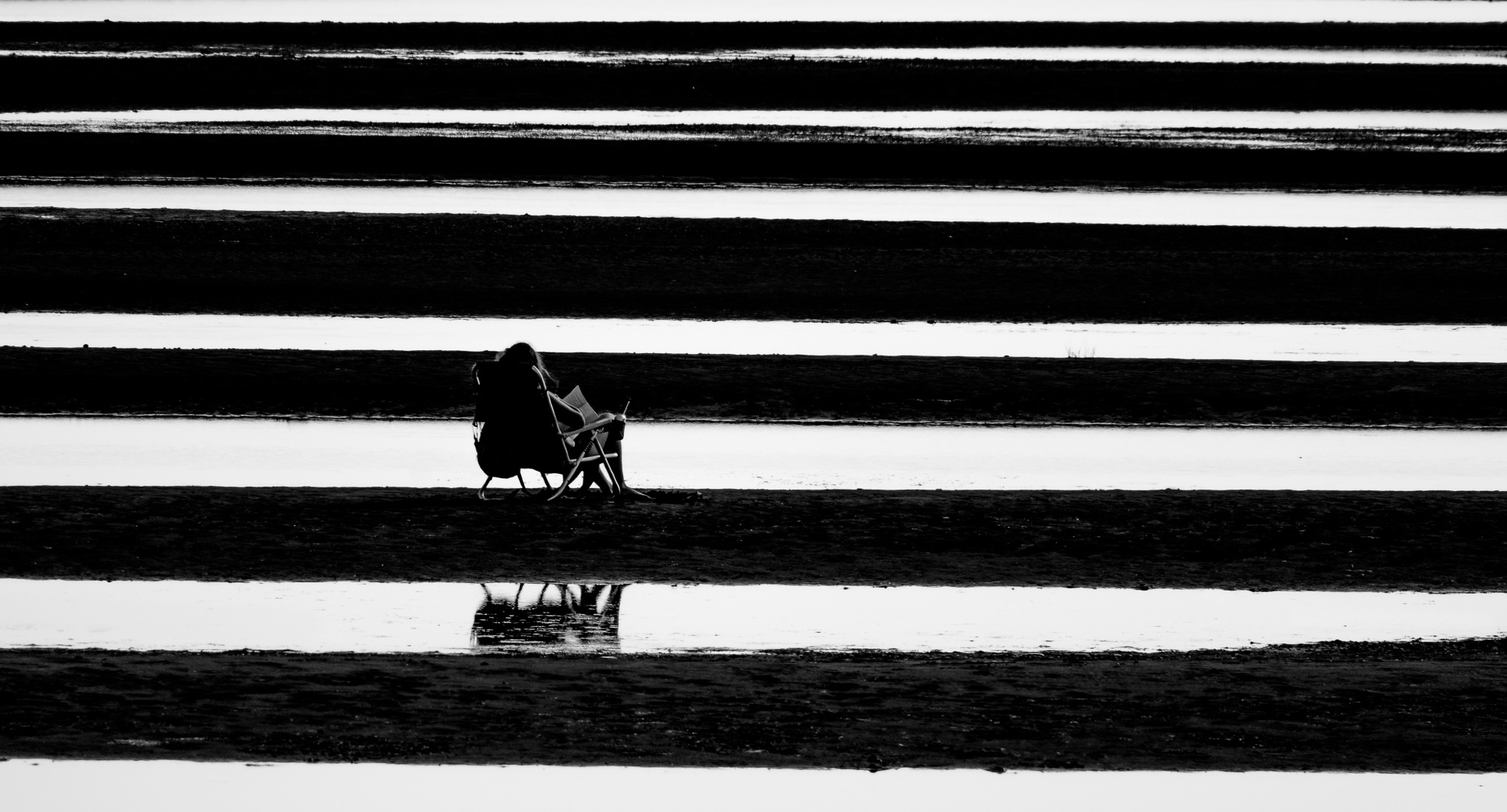Mamiya 7 II
A Hand-On Report
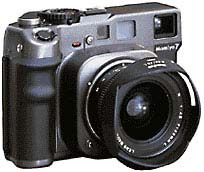
AnotherCamera?
In late 2000, Jack Zyberk submitted a review of the Mamiya 7 II to this site. Though I had no personal experience with this camera system it seemed like a fair evaluation and so I published it.
Since then I’ve encountered a number of occasions when a medium-format rangefinder camera would have made sense, particularly on field-trips with extensive hiking involved.
I’m a long-time rangefinder fan, having used a succession of M-Series Leicas both professionally and personally over many years. Recently, I’ve been a big fan of the Hasselblad XPan.
I use 35mm equipment (Canon EOS) extensively for wildlife work and specialized applications where long lenses, motor drives and similar advantages are needed. But I find 35mm film (and digital) lacking in the quality that I’m looking for when doing serious landscape work. Since 1996 my primary landscape tool has been the superb Rollei 6008. But on long or difficult hikes it can be just too bulky and heavy for the job.
At Photokina in September 2000, Bronica introduced its RF645, seemingly an ideal tool for the applications I had in mind. Its only competitor in the interchangeable-lens roll-film rangefinder arena was the Mamiya 7 II. I decided that what I would do was a shootout between these two systems and then would purchase the winner. I had a trip with some major hiking coming up, my Spring 2001 Master Class in southern Utah, and I wanted a light-weight system that also offered high-image quality for it, and future hiking trip.
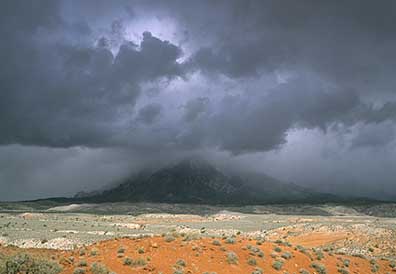 Storm Over Mt. Hillers, Utah. April, 2001
Storm Over Mt. Hillers, Utah. April, 2001
Photographed with a Mamiya 7 II and 65mm f/4 lens
![]() June, 2001
June, 2001
Mike Johnson has contributed a thoughtful rebuttal review of the Bronica RF645.
It never got as far as a shoot-out. A half hour with the Bronica and I knew it wasn’t for me. Build quality was very nice, but the first hurdle was the portrait orientation of the viewfinder. While a portrait photographer might find it irresistible, historically my landscape and travel shooting is some 75% horizontal in orientation. The camera lacks a second shutter release for when its held vertically and so I would be holding the camera awkwardly for the bulk of my shooting.Strike 1.
While the spec sheets showed it to be smaller and lighter than the Mamiya, in the flesh the difference was not that marked. Given that the Mamiya produces a 6X7cm frame, and the Bronica one that’s 6X4.5cm, the result is a negative or slide that’s 55% larger for the Mamiya.Strike 2.
The viewfinder of the Bronica is good but the data area on the left of frame is difficult to see at the same time as the main subject, and almost impossibly so when wearing glasses.Strike 3.
I won’t go on, though there are a number of other items which I found less than appealing. The camera has its strengths but up against the Mamiya it’s facing tough competition indeed.
Other Competitors
For the sake of completeness here’s a quick look at the other competitors in the rangefinder roll-film arena.Fuji is the other main player. The various GA 645 models don’t count because basically they are non-rangefinder focusing. Too much automation, roll film point-and-shoots, if you will. The GW 670 and 690 models are interesting, but neither has a built-in meter or interchangeable lenses, so that lets them out.
Mamiya 7 II
Firstly I want to mention the issue of “feel“. Possibly more than with any other hi-tech tool, the way a camera feels and handles plays a considerable role in its contribution to successful images. The Mamiya 7 is one of those rare cameras that for me at least falls-to-hand almost perfectly. The size, shape and handling characteristics are exemplary. Considering that it shoots the same format is the monster Mamiya RB and RZ67 models its diminutive size is astonishing.
The quality of materials and finish are also first-rate. Metal and plastic merge together and are almost indistinguishable. Not a single aspect is ill-fitting or inappropriate in size or location. The right-hand grip is comfortable (I have small hands) and the location of the single-stroke wind lever and shutter release essentially perfect.
In a rangefinder camera the size and brightness of the viewfinder is critical. TheM7‘s viewfinder is the largest and brightest that I’ve ever seen. The only area where an M Leica’s is superior is in the contrast of the rangefinder overlays.
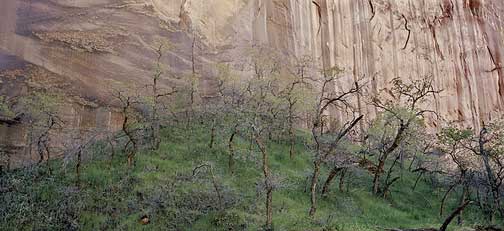 Bowns Canyon Hillside, Lake Powell AZ . April 2001
Bowns Canyon Hillside, Lake Powell AZ . April 2001
Photographed with a Mamiya 7 II and 150mm f/4.5 lens
Panoramic 35mm Adaptor
Unique among medium format cameras, the M7 takes an accessory film holder that allows it to shoot wide-format panoramic images on 35mm film. This isn’t a design afterthought, but it is a bit kludgy. The viewfinder has indicator marks for panoramic framing (though they’re not very distinct) and there’s a rewind button built into the base of the body.
The obvious question is, why would one want to do this since it’s trivial to shoot 120 roll film and then simply crop a wide-format image that matches in every way what one can shoot with the adaptor. But this misses several points. One is economy. It’s a lot less expensive to shoot 35mm film than 120 roll filmifwide-format panoramics are what one is trying for. The second is film availability. Outside of professional photographic stores in large cities it’s almost impossible to find 120 or 220 format film. With a 35mm adaptor in ones bag the camera is able to shoot any 35mm emulsion if needs be, and of course these can be cropped down to more normal framing if desired.
Having said all that, frankly, though I bought one, if I had to do over again I wouldn’t have bothered.
Lenses
There are currently 6 lenses available for the Mamiya 7II. I chose three for my travel kit; the 43mm f/4.5, 65mm f/4 and the 150mm f/4.5. These are equivalent to 21mm, 32mm and 71mm lenses in 35mm terms. The 65mm is the widest lens for which the M7 has a built-in frame line. Similarly the 150mm is the longest lens that doesn’t need an accessory viewfinder, (though one is available as an extra-cost accessory, it really isn’t needed). The 43mm focuses with the camera’s inbuilt rangefinder but framing is with the supplied auxiliary viewfinder that mounts on the accessory shoe.
All three lenses have excellent reputations. Photodo gives the 43mm a 3.7 rating, 65mm a rating of 3.8 and the 150mm a rating of 4.3. These are all excellent ratings. In fact the 150mm lens rates higher than any other medium format lens they’ve ever tested. It uses UD glass and though Mamiya doesn’t call it that, it is in fact a true Apochromat. The 43mm is a classic Biogon true wide-angle design (not retrofocus) and is remarkably free from distortion.
Photographed with a Mamiya 7 II and 43mm f/4.5 lens
Polarizer
Polarizers are the most commonly used filter for most outdoor photographers. But RF cameras make them awkward to use, usually requiring setting them by eye and then attaching them to the lens at the correct orientation. Slow and error prone.
A new addition to the Mamiya lineup is the ZE702 Polarizing Filter. This is a complex, elegantly designed device. It attaches to any of the Mamiya’s lenses via their lens shade mounting points and an included bayonet adaptor. Once attached the filter swings upward via a parallelogram arm system so that it is above the top of the camera. Looking over the top of the camera you rotate the filter while in this position for optimum polarization and then simply swing it back down in front of the lens. It retains its proper orientation as it swings. When in the viewing position it is also in front of the camera’s meter, so manually setting the proper exposure at this time is also possible.
Quite elegant, though it takes a little while to become familiar and comfortable enough to use the device quickly in the field.
Some Gripes & Problems
For all of its many strengths the Mamiya has a few problems, though none of them are showstoppers. The first gripe is the manual. My guess is that it was written by someone who failed English as a second language – badly. I haven’t seen a Japanese camera’s manual with so many errors and unintentionally funny typos in decades. Millions are spent on R&D, manufacturing and marketing yet they won’t spend $500 for a decent translation and some proofreading. I don’t get it.
The viewfinder, as excellent as it is, must have a polarizing element incorporated. This increases contrast but also makes it impossible to use when wearing polarizing sunglasses as the view almost goes black at certain angles. This is a serious flaw.
The shutter release is hair-trigger. This is a problem particularly when wearing gloves, as the lack of sensitivity can lead to inadvertent shutter release, because an extremely light touch is all that’s needed to turn on the meter. At about $1 per frame for colour transparency film and processing one doesn’t make this mistake too often.
The rangefinder baseline is a bit short for the 150mm lens at just 60mm. This makes exact focusing at wide apertures somewhat problematic. (See below for more on this).
The thumb-wind lever is single stroke. My preference would be to have it ratcheted.
Because the built-in meter is through the viewfinder rather than behind the lens there’s no automatic compensation for the use of filters. The exposure compensation dial makes this easy to work with but it’s necessary to remember to reset it, particularly after using the polarizer.
When changing lenses it’s necessary to turn a lever on the camera’s base to close a shutter curtain and protect the film. The Bronica RF645 does this automatically. Score 1 for the Bronica.
The depth of field scales on the lenses are inappropriately calibrated. Mamiya uses a (COF) c ircle o f c onfusion that is at least 2 stops too optimistic. If all you’re making is non-critical 8X10″ prints then they’re probably OK. But, if you make 11X14″ (A3) or larger prints, and want the sharpest possible images, then use the markings for at least 2 stops less. In other words, with the 65mm lens set to its hyperfocal point of 10ft and a F stop of f/22, the lens markings indicate a depth-of-field of from 5 ft to Infinity. You should instead focus the lens as if you were using f/11 (though you’re still really using f/22). This will mean that prime focus is at 20 ft and depth of field is really only 10 ft to Infinity – half the near focus distance then the lens would have you believe.
The Rangefinder and 150mm Lens
My experience has been that with the shorter lenses there is no issue in terms of accurate focusing. But, with the 150mm lens the rangefinder is pushing the envelope in terms of accuracy. The trick that I’ve developed isnotto rack the lens back and forth the way one does with ground-glass focusing. Instead, start at one end, turn the focusing ring slowly, and then stop when the coincident images align. This avoids any backlash in the rangefinder cam system.
Finally, you’ll notice especially when using the 150mm lens, that the lens focusesbeyondinfinity. This, according to Mamiya is to allow for expansion in very hot weather. Consequently, even when shooting distant landscapes it isn’t good enough to simply rack the lens over to its end stop. You actually have to focus on infinity.
Even so, too high a percentage of photographs taken with the 150mm lens are unsharp due to focusing problems. Caveat emptor.
On Location
Only a couple of weeks after purchasing the M7 I was off an a major photographic trip which I had organized; a Master Class Workshop in southern Utah. It consisted of a week on a houseboat on Lake Powell and a week traveling to and from the lake, through Bryce, Zion, Capital Reef and Grand Staircase Escalante national parks.
My intention was to use the M7 system when hiking, and the Rollei 6008 system for the rest of my work. As it turned out 2 of my 4 Rollei lenses packed it in during the trip and I ended up using the Mamiya for at least 90% of the 75 rolls that I shot during those two weeks. I found the camera a joy to use when hiking. I didn’t even take a camera bag along in long hikes, just the camera around my neck and the two other lenses in the pockets of my shooting vest. My tripod was on a sling over my shoulder, and additional film and a polarizer filled up some additional pockets.
Instead of my usual 30lb backpack I found this set-up was ideal for hikes up the canyons of theEscalante River. Some of the hikes were a couple of miles over rugged terrain and 3-4 hours in duration. I found that I could cover a lot more ground, more comfortably then ever before. I missed having a lens longer than 150mm along, but the wide angle end was covered nicely by the 43mm.
The photographs displayed on this page are from that trip.
My sense is that if you want a camera system that will give you the largest possible negatives and highest image quality combined with the lightest possible weight and bulk it would be hard to find another camera that bests the Mamiya 7 II.
International Pricing
Though it’s been recited on these pages (and elsewhere) many time before, be aware that Mamiya pricing in the United States and Canada is quite out of line with prices elsewhere in the world. By this I mean as much asdoublewhat people in other countries pay. For example, in the UK a Mamiya 7 II body can be bought for $1,100, while the typical US price is about $2,000. (All prices are US dollars, taxes not included.) With the web allowing competitive shopping on a global basis there’s no reason not to shop around. (There is no duty on camera bodies entering the United States. The duty on lenses is 2.3%).
Robert White is a leading U.K. photographic equipment distributor and dealer who ships product all over the world. I also highly recommend HarrysProShop, another reputable online dealer located in Canada who ships to all countries. I have purchased equipment from both companies and know them to both be efficient and reputable.
After less than a year with the Mamiya system I sold it. Ultimately, though I very much appreciated the light weight and great handling of the M7, I found that I never got completely comfortable with it – for several reasons.
My main problem was in using a rangefinder camera for landscape work. Yes it can be done, yes, many photographer do it. No, I never because comfortable with it.Ineed a groundglass image to compose properly.
The second concern was the 150mm lens. I just never found myself able to focus properly with it. I had the system checked and there was nothing wrong with either the lens or the camera. But I just ended up with too high a percentage of shots that were out of focus. I have no such problems focusing with my M Leicas or the Hasselblad XPan though. No finger pointing. It just didn’t workfor me.
So, what did I do? I ended up selling the Mamiya and purchasing a Pentax 67 II outfit. Not as small and light as the Mamiya, but still preferable to my Rollei system for hiking situations. Sometimes great cameras work for some photographers and not for others. The Mamiya 7 and I were one such case.
Read this story and all the best stories on The Luminous Landscape
The author has made this story available to Luminous Landscape members only. Upgrade to get instant access to this story and other benefits available only to members.
Why choose us?
Luminous-Landscape is a membership site. Our website contains over 5300 articles on almost every topic, camera, lens and printer you can imagine. Our membership model is simple, just $2 a month ($24.00 USD a year). This $24 gains you access to a wealth of information including all our past and future video tutorials on such topics as Lightroom, Capture One, Printing, file management and dozens of interviews and travel videos.
- New Articles every few days
- All original content found nowhere else on the web
- No Pop Up Google Sense ads – Our advertisers are photo related
- Download/stream video to any device
- NEW videos monthly
- Top well-known photographer contributors
- Posts from industry leaders
- Speciality Photography Workshops
- Mobile device scalable
- Exclusive video interviews
- Special vendor offers for members
- Hands On Product reviews
- FREE – User Forum. One of the most read user forums on the internet
- Access to our community Buy and Sell pages; for members only.






